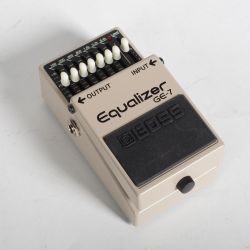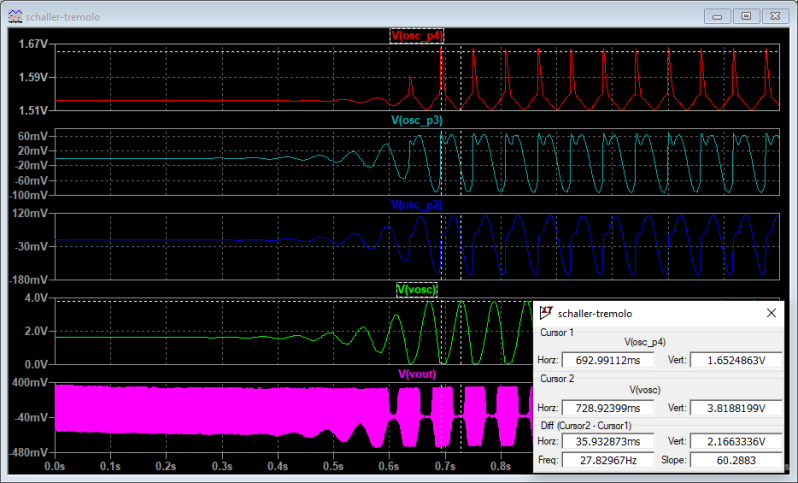Musicians have a fantastic language to describe signals. A sound can be fat, dark, crunchy, punchy — the list goes on. These aren’t very technical terms, but they get the job done. After all, it’s much easier to ask to guitarist for a crisper sound than to ask them to sharpen the edges of the waveform, while amplifying the high-frequency  components and attenuating the low-frequency components. Of course, it’s fun to look at signals this way as well, especially when you can correlate shifts in sound quality to changes in the waveform and, ideally, the circuit that produces it.
components and attenuating the low-frequency components. Of course, it’s fun to look at signals this way as well, especially when you can correlate shifts in sound quality to changes in the waveform and, ideally, the circuit that produces it.
To undergo such an investigation, [Nash Reilly] has been simulating guitar effects pedals in LTSpice. Able to find most of the schematics he needs online, [Nash] breaks down the function of each part of the circuit and builds a simulation of the entire system. His write-up clearly explains, and often demonstrates, what’s going on inside the box. On the surface, it’s an interesting tour of the inner workings of your favorite effects pedals. Beyond that, it’s an excellent survey of analog design that is well-worth the read for anybody interested in audio, electronics, or audio electronics.
For those interested in taking the physical route rather than the simulated one, we’ve taken a look at pedal design before. Anybody who wants to try their hand at creating simulations can grab a copy of LTSpice, or check out a package called LiveSpice, which lets you simulate circuits in realtime and use them to process live audio — pretty useful for prototyping guitar effects.















Why would PSpice be better over LTSpice? I’m interested in any application PSpice is superior. I don’t know of any application and LTSpice is substantially faster to simulate. The only thing LTspice doesn’t do perhaps as well is support 3rd part models, it can be a chore to import them. But no one supports 3rd party models per se, they are 3rd party, and its a chore regardless.
I’ve used LTSpice. I’ve also used the current version of the original Berkeley SPICE with its display program Nutmeg. Berkeley SPICE is somewhat inconvenient, but produces more accurate results than LTSpice. If I recall correctly, Linear Technology developed LTSpice to effectively model switching power supplies, and the optimizations they made for power supplies hurt other types of circuits.
As an “electronics-enthusiast” (eager know nothing) I’m psyched this method worked! I had wanted to try this years ago but my EE friends told me to not bother due to lack of computing power (back then) to output audio in a reasonable time frame.
Time to put this higher on my project list!
Many VST plug-ins for pro and semi-por audio already do this for classic circuits. I’d love to see an article on the magic of the Fairchild 670 compressor or AM-864.
Duncan’s amp pages are an excellent source of tube models for valve simulation goodness:
http://www.duncanamps.com/technical/ltspice.html
If using LiveSpice, you’ll want reasonably low latency audio IO. It’s good fun but doesn’t quite pull off the smoothness of a protoboard based circuit.
While listing spice type software, SiMetrix intro is rather good:
https://www.simetrix.co.uk/downloads/
Nice! I used ngspice to simulate the Maestro Fuzz Tone a while back, based on the 1962 Snoddy patent. The tricky bit was getting a good model for the germanium transistors. http://www.grwster.com/projects/2020/germaniumfuzzsim/
My favourite effect remains what sounds like a divide by 2 or 4 presumably using a J-K flip flop or two, which turns a bass guitar into a sharper sound, but one or two octaves lower.
As used by The Stranglers on “In the Shadows”.
I must build one!
But a Bodhran played through a flanger is quite enjoyable, too.
Yeah, I’m using an octave doubler for my bass guitar for a deep smooth synthetic punch. It’s been a popular sound with 80s jazz-fusion musicians, like on Chick Korea’s Elektric City. Roger Mayer built the Octavia that Hendrix used on Purple Haze and Fire 🔥and that piercing bayonette-like guitar sound on Machine Gun. Thanks 👍 for putting me on to The Stranglers, great stuff.